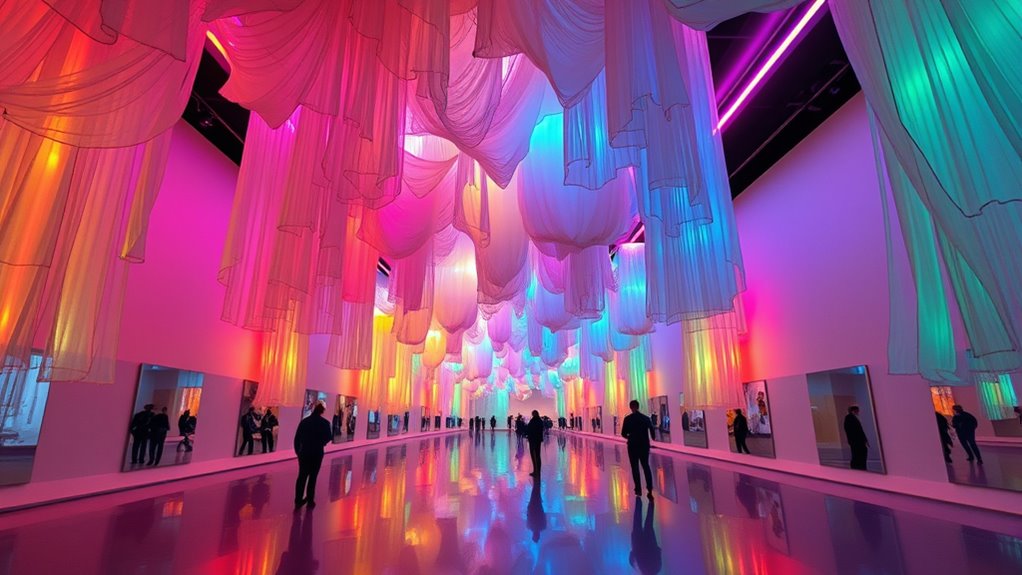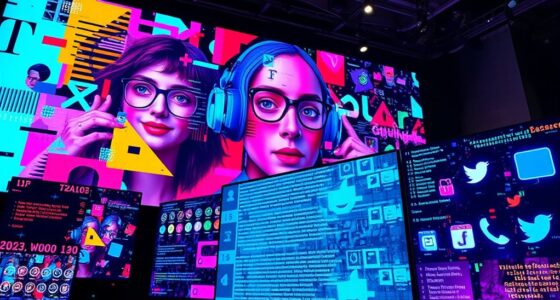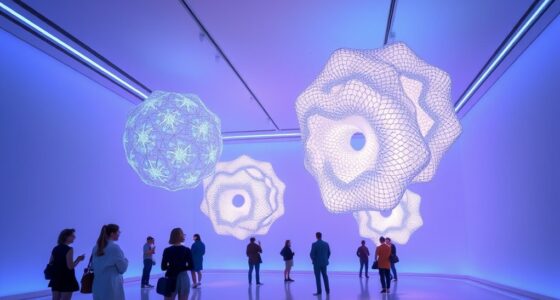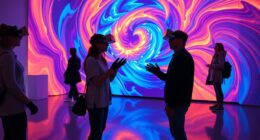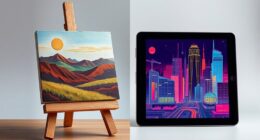You’ll find that installation art has transformed galleries into immersive environments that actively involve you in the experience. Originating from early avant-garde movements, it now uses tech like virtual reality and digital projections to create multisensory, site-specific works. Artists invite you to participate, blurring lines between viewer and creator. This shift has broad social and cultural impacts, encouraging dialogue and engagement. If you continue exploring, you’ll discover how these immersive experiences keep evolving beyond traditional art spaces.
Key Takeaways
- Installation art incorporates immersive environments that engage multiple senses, transforming viewer participation in galleries and public spaces.
- Advances in digital technology, such as virtual reality and projections, enhance the immersive experience beyond traditional gallery settings.
- Artists create site-specific works that respond to architecture and landscape, fostering deeper connections with local communities.
- Audience participation shifts from passive observation to active involvement, encouraging social dialogue and societal reflection.
- Installation art’s flexibility—temporary or permanent—allows for innovative, dynamic experiences that evolve with technological and cultural trends.
The Origins and Evolution of Installation Art
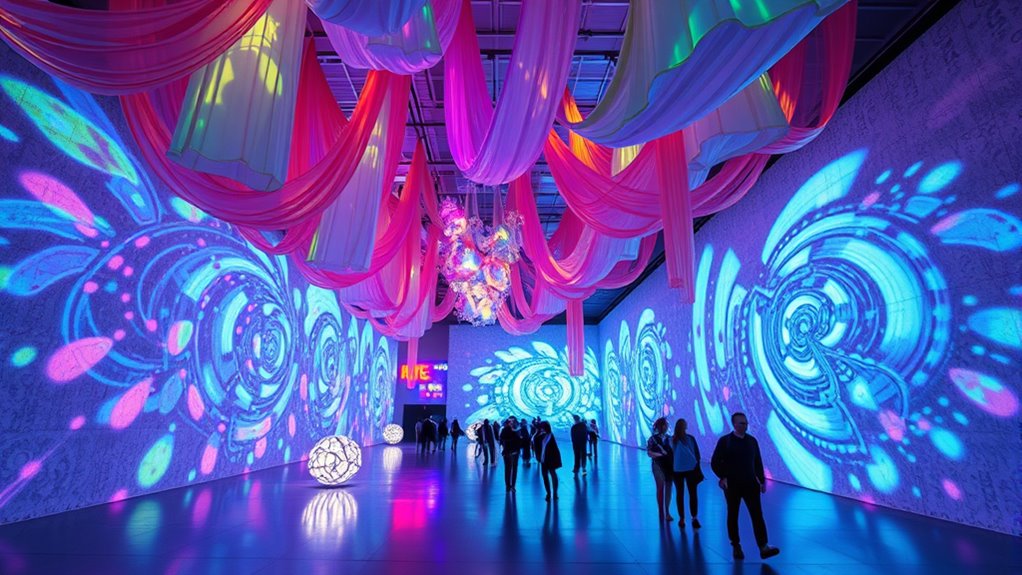
Installation art has roots that stretch back to early 20th-century avant-garde movements, where artists began challenging traditional notions of art. Marcel Duchamp’s readymades, like *Fountain*, questioned what could be considered art, paving the way for new approaches. Movements such as Dadaism and other avant-garde styles inspired artists to experiment beyond conventional forms. During the 1960s, artists like Allan Kaprow created environments that blurred the line between art and life, setting the stage for installation art. This period marked a shift from focusing solely on objects to creating immersive environments. Conceptual art also emerged, emphasizing ideas over aesthetics. Over time, installation art evolved into a multidisciplinary practice, incorporating diverse materials and expanding into public spaces, influencing contemporary art and society. Additionally, the use of space and environment became a fundamental aspect of installation art, allowing artists to transform viewer perceptions. The integration of audience interaction further enhanced the immersive quality that characterizes much of modern installation work. Moreover, contemporary artists often explore themes of social commentary, making installation art a powerful tool for societal reflection. Recent developments have also seen the integration of digital technology, expanding possibilities for interactive experiences within installation projects, with artists increasingly utilizing technological innovations to deepen audience engagement.
Characteristics That Define Immersive Environments
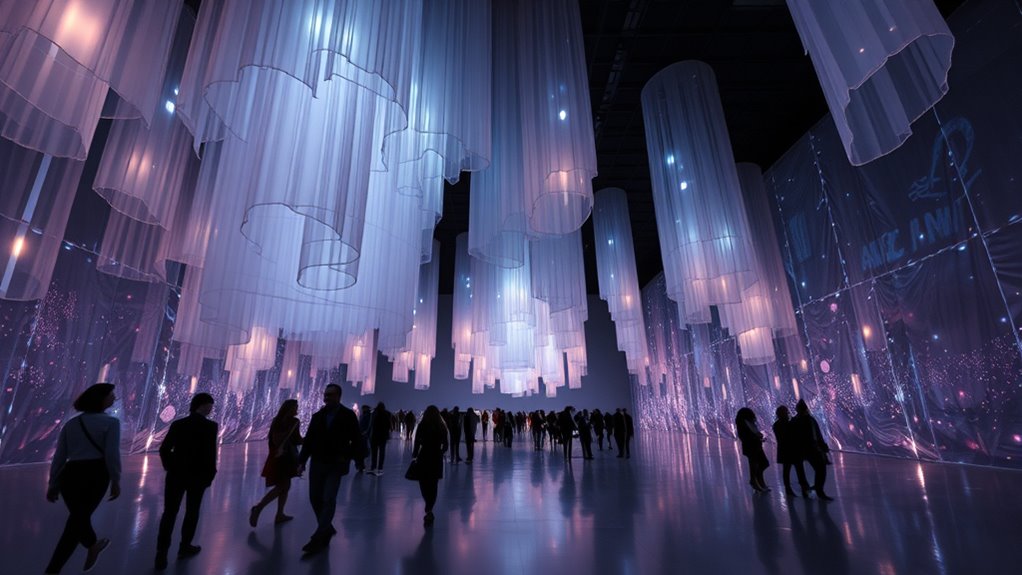
Immersive environments are characterized by their ability to fully engage your senses and draw you into a carefully crafted space. You’ll experience multisensory elements like sound, light, and smell that create a holistic experience. These installations are often site-specific, transforming the environment and making each interaction unique. Many are temporary, traveling between galleries to keep the experience fresh and exclusive. Technology plays a key role, with virtual reality and digital projections blurring the lines between reality and art. The space itself is manipulated to evoke emotions and tell stories, encouraging you to participate actively rather than passively observe. Incorporating principles from the Law of Attraction, these environments can be designed to influence your vibrational energy and enhance emotional engagement. Additionally, the use of interactive elements can deepen your sense of immersion and personal connection to the artwork. Understanding resources and tools available for creating such environments can further elevate the impact of immersive art experiences. For example, integrating specialized equipment can help achieve more compelling sensory effects and realism, especially when combined with space optimization techniques to make the environment more inviting and functional.
Pioneering Artists and Landmark Works

Throughout the development of installation art, pioneering artists have pushed boundaries and expanded creative possibilities. Marcel Duchamp’s use of everyday objects laid the groundwork, while artists like Kurt Schwitters transformed studios into collage environments. Yayoi Kusama creates immersive infinity spaces, challenging perception. Marcel Broodthaers incorporated mundane materials to question art’s role, and Gordon Matta-Clark used architecture for site-specific works. Judy Chicago’s collaborative installations explore feminist themes. Landmark works like Jason Rhoades’ “Swedish Erotica and Fiero Parts” highlight culture through ordinary items, while Kara Walker’s silhouettes confront race and gender. Joseph Beuys’ installations with felt and lard evoke warmth and protection. These artists and works revolutionized how we experience space, ideas, and societal issues in immersive environments. Installation art emerged mainly in the second half of the 20th century alongside minimalism and conceptual art. Additionally, the integration of creative practice into installation art has encouraged artists to experiment with diverse mediums and innovative techniques, often emphasizing audience engagement as a core element of immersive experiences. Recognizing the importance of artistic innovation has helped shape the ongoing evolution of the genre. Incorporating unique and wicked planters as part of these immersive environments has further expanded the scope of spatial creativity and audience interaction.
The Role of Site-Specific and Public Installations

Site-specific and public installations transform ordinary spaces into compelling artistic experiences by responding directly to their environment. They integrate with the physical characteristics of a site, such as architecture or landscape, and often reflect local culture or history. These works can take various forms, from sculptures to graffiti, and create immersive interactions for viewers. Public installations, whether in urban areas or remote settings, increase accessibility and foster community engagement. They often serve as cultural symbols, promote local pride, and attract visitors, boosting the economy. Some installations are temporary, adding a dynamic element to public spaces, while others remain permanent. By adapting to their surroundings and involving local communities, these installations deepen your connection to place and expand the reach of art beyond galleries. For example, the renowned artist Mark Wallinger recreated Brian Haw’s Protest in Parliament Square as an installation that responded to its political and physical environment. Recognizing the importance of environmental context can enhance the impact of these works and foster meaningful dialogue with diverse audiences. Additionally, leveraging cultural relevance ensures that installations resonate more deeply with their audiences and reflect local identities. Incorporating cost considerations into planning can also help ensure the sustainability and success of public art projects. Considering installation durability can further influence how long an artwork remains impactful and engaging for the community. Moreover, understanding funding sources and securing appropriate support can significantly influence the realization of these projects and their ongoing maintenance.
Technological Innovations Transforming the Medium

Technological innovations like virtual reality and interactive digital media are reshaping how you experience installation art. VR creates immersive worlds that transport you beyond physical boundaries, while interactive media respond to your presence, making each encounter unique. These tools are expanding artistic possibilities and changing the way you engage with and interpret installations. Additionally, these technologies promote ecological awareness by enabling artists to craft environmentally conscious and sustainable virtual environments that reflect green practices in 2025. Incorporating industry trends ensures that these innovations remain relevant and forward-thinking in the evolving art landscape. Moreover, data analytics assist artists in understanding audience engagement and refining their immersive experiences to better suit viewer preferences. Emphasizing technological innovation allows artists to push creative boundaries and explore new forms of expression within immersive environments.
Virtual Reality Integration
Virtual reality has revolutionized the way art is experienced by making exhibitions more immersive and accessible. You can now explore artworks regardless of your location or budget, breaking down traditional barriers. VR transforms standard exhibitions into enthralling narratives that deepen your engagement and understanding. It also offers a cost-effective way for institutions to expand their reach, attracting wider audiences. The technology enables immersive storytelling, allowing you to step into historical contexts or explore collections in ways that feel authentic and educational.
- Access art globally, reducing physical and financial barriers
- Experience immersive, educational narratives in virtual environments
- Engage with art interactively, enhancing connection and understanding
Interactive Digital Media
Interactive digital media is transforming installation art by harnessing innovative technologies that respond directly to viewer actions. Sensors detect your presence and movements, making the experience dynamic and personalized. Motion tracking systems follow your gestures, allowing installations to adapt in real-time. Interactive screens invite you to engage directly with digital content, while cameras analyze your interactions to influence the artwork’s response. Projector technology creates immersive environments by projecting visuals onto surfaces, transforming spaces into lively, interactive scenes. These tools enable the creation of digital projections, responsive sculptures, and expansive immersive environments. As a viewer, you become an active participant, fostering emotional connections and personal interpretations. These innovations blur the boundaries between artist and audience, pushing the limits of artistic expression and cultural relevance in contemporary installation art.
Engaging Viewers: From Passive Observation to Active Participation
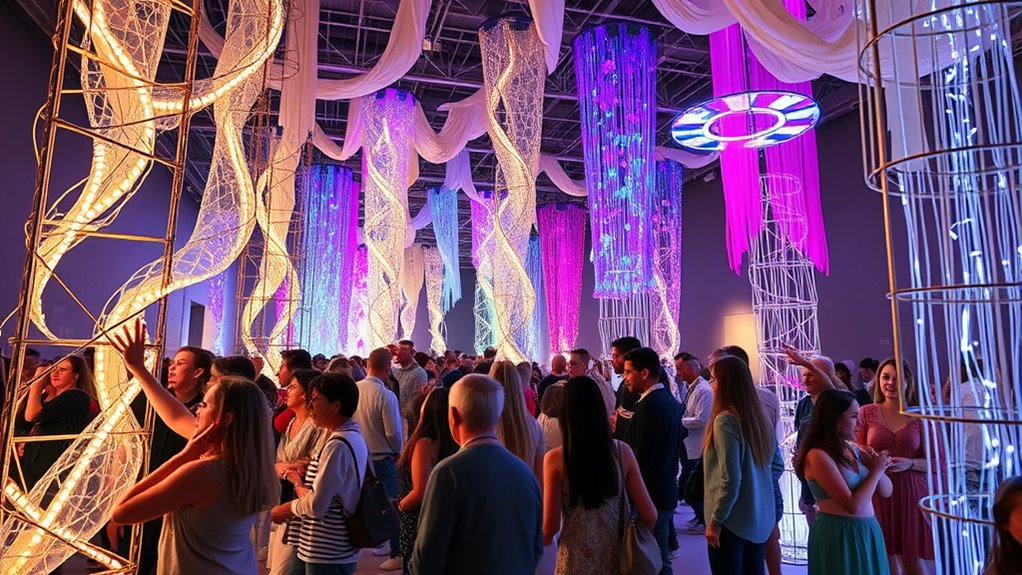
Over time, the relationship between viewers and installation art has shifted from passive observation to active participation. You’re no longer just an observer; you become part of the artwork. Artists now design experiences that encourage touch, movement, sound, or digital interaction. Technologies like VR, AR, sensors, and responsive lighting enable immersive environments where your actions influence the piece in real-time. This shift fosters emotional engagement, empowerment, and a sense of community among participants. However, designing these experiences requires balancing accessibility, simplicity, and intuitive interfaces to ensure everyone can participate meaningfully. Curators and artists collaborate more closely, creating evolving works shaped by audience input. This transformation turns viewers into active co-creators, making installation art a dynamic, shared experience rather than a static display.
- Technologies like VR, AR, and sensors enable real-time interaction
- Participation involves touch, movement, sound, or digital interfaces
- Audience engagement fosters emotional investment and community
The Cultural and Social Impact of Contemporary Installations
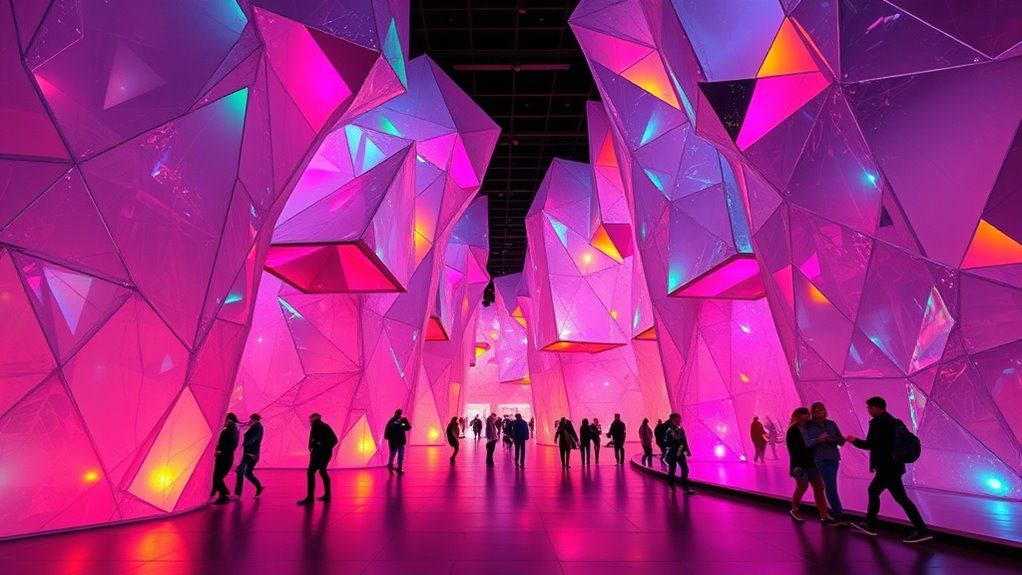
Contemporary installations have the power to spark social dialogue and bring communities together through shared experiences. They challenge cultural norms by encouraging viewers to question and reflect on societal issues. As you engage with these works, you’ll see how they foster deeper community involvement and promote meaningful conversations.
Promoting Social Dialogue
How do installation art projects foster meaningful social dialogue? They create interactive spaces where diverse voices can share experiences, challenge perceptions, and spark conversations. These projects often address pressing social issues like mental health and trauma, making taboo subjects more visible and encouraging community reflection. By involving participants in the creation process, installations foster civic engagement and a sense of shared ownership. They serve as platforms for non-verbal communication, bridging cultural and linguistic divides, and inspiring dialogue on political and social topics. The immersive nature invites repeated visits, deepening understanding and empathy. These projects can influence public opinion and policy, transforming passive viewers into active participants in societal change.
- Address social issues openly to reduce stigma
- Engage communities through collaborative creation
- Encourage ongoing reflection and discussion
Enhancing Community Engagement
Installation art projects do more than promote social dialogue—they actively strengthen community bonds and foster local identity. When you participate in planning, creating, or maintaining public installations, you help build a shared sense of ownership and pride. Arts initiatives involving residents boost trust and social capital, leading to greater cohesion within neighborhoods. Events centered around installations encourage active social interaction, transforming viewers into engaged participants. Public art that reflects local culture and incorporates community input makes residents feel seen and valued, reinforcing their connection to the area. This sense of inclusion boosts civic engagement, supports local businesses, and creates safer, more vibrant communities. Ultimately, these immersive experiences help you feel more connected, fostering a collective identity rooted in shared participation and cultural expression.
Challenging Cultural Norms
Challenging cultural norms through art allows communities to question long-held beliefs and explore new perspectives. Installation art often uses found objects and everyday materials, expanding what qualifies as art and encouraging viewers to reconsider their surroundings. Public installations transform urban spaces, fostering community attachment and cultural identity. Interactive and technological elements create immersive experiences that push boundaries, making art more accessible and engaging. These installations blur the line between art and daily life, prompting reflection on societal roles and values. By incorporating local themes, they strengthen community bonds and challenge traditional notions of art confined to galleries. Overall, contemporary installations serve as powerful tools for social critique, inspiring dialogue and cultural evolution.
- Use of found objects and everyday materials broadens artistic scope
- Immersive, interactive experiences challenge perceptions
- Public art fosters community identity and social cohesion
Frequently Asked Questions
How Do Installation Artists Choose Materials to Create Immersive Environments?
You choose materials for immersive environments by considering your artistic vision, site conditions, and audience interaction. You balance durability, environmental impact, and budget constraints, selecting traditional or contemporary options accordingly. You experiment with innovative uses, integrate technology, and guarantee materials are low-maintenance and weather-resistant. Collaboration and community engagement influence your choices, helping you craft dynamic, sustainable, and impactful installations that resonate and evolve over time.
What Are the Challenges of Maintaining Temporary Site-Specific Installations?
Imagine assembling a complex LEGO set in a storm—maintaining a temporary, site-specific installation feels just as chaotic. You face permit delays, weather threats, and coordination hurdles with stakeholders. Materials must be safe, durable, and easy to remove, while site constraints limit your design. Budget tightens your options, and environmental concerns add pressure. Keeping everything intact and safe until de-installation requires constant vigilance and precise planning.
How Does Audience Interaction Influence the Meaning of Installation Art?
When you interact with installation art, you actively shape its meaning, making each experience unique. Your gestures, digital inputs, or even voice can change the artwork’s form, sound, or visuals in real time. This dynamic interaction deepens your emotional and perceptual connection, blurring the line between artist and viewer. As a participant, you become part of the creative process, transforming the artwork’s message and fostering a more personal, collaborative experience.
In What Ways Do Technological Advances Expand Installation Art’s Accessibility?
You see how technological advances expand installation art’s accessibility by enabling virtual tours and online platforms, so you can experience it from anywhere. Augmented reality and digital tools allow you to interact with artworks beyond physical spaces. Social media shares these experiences globally, making art more inclusive. Public tech like LED displays and interactive screens also bring art into communities, inviting everyone to engage, regardless of location or physical ability.
Are There Ethical Considerations in Creating Socially Engaged Installation Works?
You should consider ethical issues when creating socially engaged installation works. It’s crucial to respect cultural sensitivities, build trust through genuine community engagement, and guarantee participant autonomy. You also need to address safety, environmental impacts, and legal considerations like permits and copyright. By prioritizing collaboration and consent, you can create impactful art that raises awareness without causing harm or perpetuating stereotypes. Ethical practices strengthen your work’s social responsibility and authenticity.
Conclusion
As you step into the world of installation art, you become part of a shifting landscape where walls whisper stories, lights pulse with emotion, and textures invite touch. These immersive environments dissolve boundaries, pulling you into a vivid tapestry of sight, sound, and sensation. You’re no longer a mere observer but an active participant, experiencing the evolving dialogue between artist, space, and audience—transforming galleries into living, breathing worlds that spark your imagination and challenge your perceptions.

